This post explains how to disable or enable Out of Office replies in MS Outlook. Out of Office is a feature that enables users to send responses to Outlook emails automatically. Employees often use this feature to notify people of their absence when they are on vacation, traveling for work, or otherwise temporarily unavailable to respond to the messages. It helps manage expectations among clients and colleagues, preventing confusion when emails go unanswered.
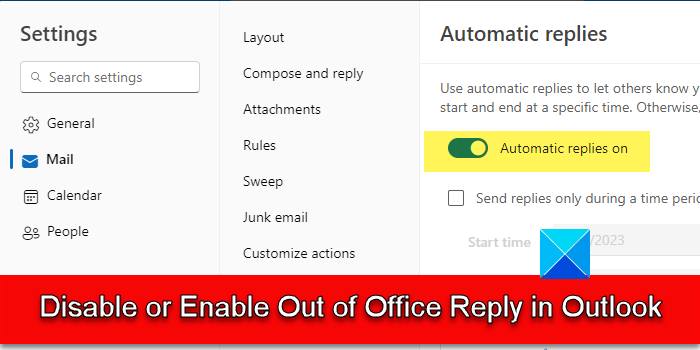
By default, the Out of Office feature is disabled in Outlook. When you activate the feature, Outlook allows you to craft a response that will be used to reply to the emails received in your absence. This response typically consists of a custom message that tells the receiver that you are out of the office.
How to Disable or Enable Out of Office Reply in Outlook
In the following section, we will look at how to disable or enable Out of Office replies in different Outlook versions. We will also show you how to create an out-of-office ‘rule‘ if your Outlook version doesn’t support the feature (the availability and functionality of the feature may vary depending on the version of Outlook you’re using and your mail configuration settings).
Please note that the feature is exclusive to the Mail client in Outlook. If you’re in Calendar, People, or some other module in Outlook, you won’t be able to access the Out of Office feature. Also, replies are sent only once to each sender for a given activation period.
1] Enable or Disable Out of Office Reply in Outlook for the Web
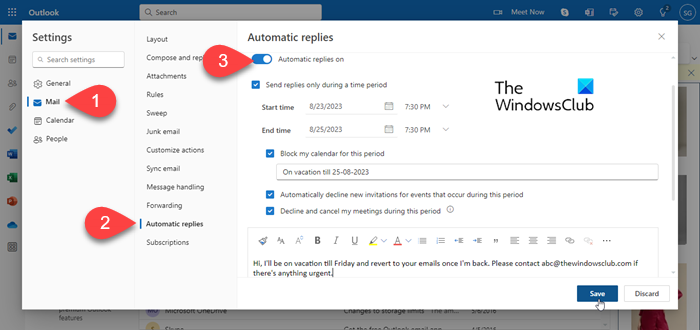
Login to your Outlook.com account and click on the gear icon in the top right corner. Settings window will appear. Click on the Mail option in the left panel. Then click on Automatic replies (second option from the bottom).
In the Automatic replies section, you will see a Turn on automatic replies toggle button. Click on the toggle to enable or disable Out of Office reply for your Outlook Mail account.
Once you turn on the feature, you can set up Automatic Replies in Microsoft Outlook.
2] Enable or Disable Out of Office Reply in Outlook client
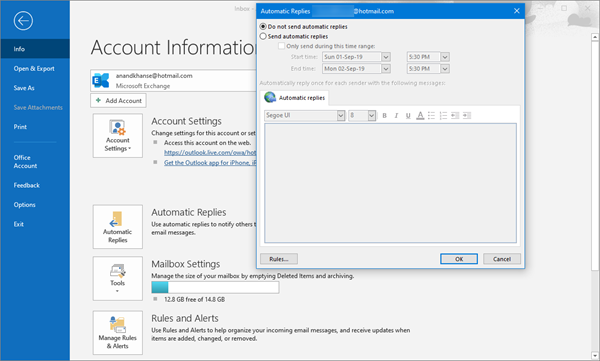
To enable or disable Out of Office Reply in Outlook desktop client, follow these steps:
Go to your Outlook mailbox and click on the File menu in the top-left corner. In the right panel (under Account Information), click on the Automatic Replies (Out of Office) option.
Note: You may not see this option if you don’t use an @outlook.com email address or you don’t have an Exchange account. In that case, you may create an out-of-office rule to send automatic replies, as explained in the upcoming section.
The Automatic Replies configuration window will appear. Click on the Send automatic replies radio button to enable Out of Office Reply for your mailbox.
Then, select a time frame for sending the response (optional) and compose the reply. Use the Inside My Organization tab for emails from your colleagues or your organization’s Exchange server. For responses to external contacts, use the Outside My Organization tab. Click on OK to save changes.
If you didn’t choose a time frame for the Out of Office replies, the feature will activate immediately and won’t turn off until you manually disable the feature.
To disable the feature, select the Do not send automatic replies option and click on the OK button.
3] Creating an Out of Office rule – all versions
If you can’t see the option to send automatic replies, you can set up an automated response using an email template and a few Outlook rules. Here’s how:
Go to your mailbox and click on the New Email option in the top left corner. A compose new email window will appear. Draft an Out of Office response by entering an appropriate subject line and content in the mail body.
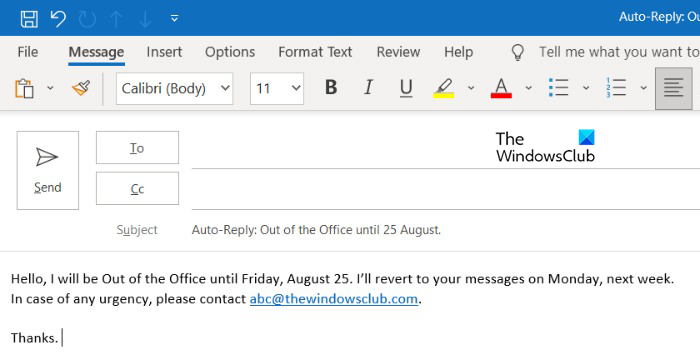
Next, save your template. Click on the File > Save as option. Save as dialogue box will appear. Enter a name for the template and select Outlook Template (*.oft) in the Save as type: dropdown. Click on the Save button to save the template.
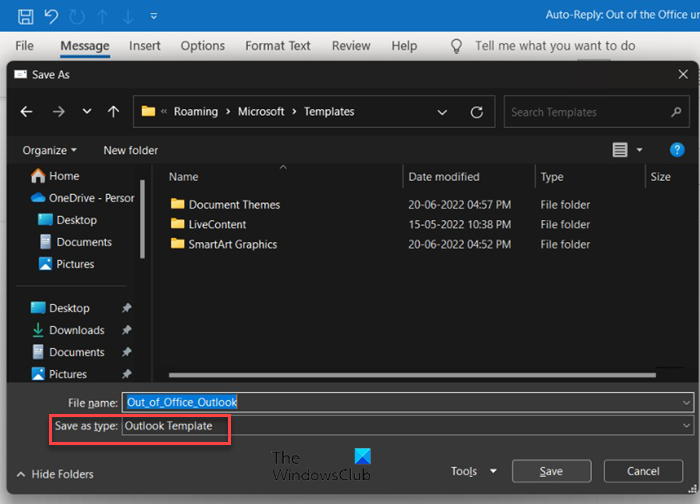
Next, click on the File menu. Select Rules and Alerts under Account Information.
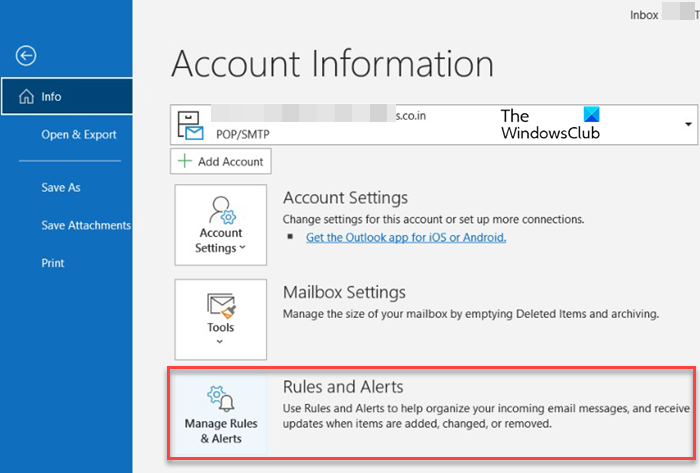
The Rules and Alerts dialogue box will appear. Click on the New Rule button under the Email Rules tab.
Rules Wizard will open up to help you set the rule. On the first screen of the wizard, select Apply rule on messages I receive under Step 1 to start from a blank rule. Click on the Next button.
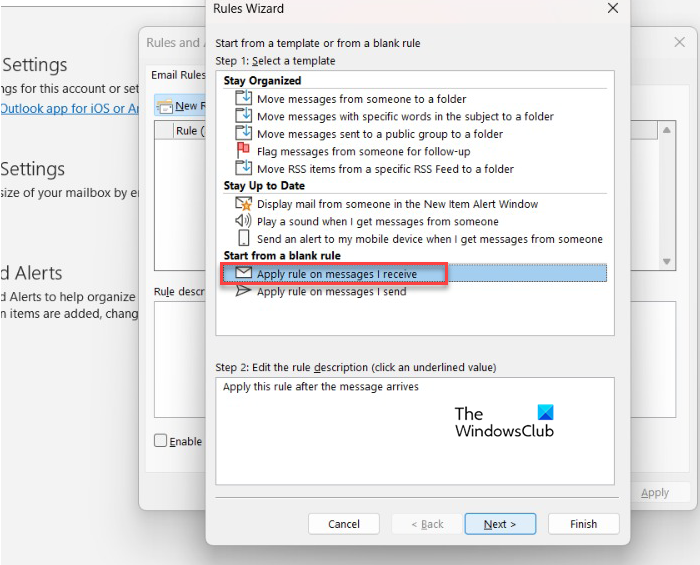
On the second screen, select the condition(s) to be checked under Step 1. For example, select where my name is in the To box to apply the rule on received messages that have your name in the ‘To’ field. Click on the Next button to move to the next step.
On the third screen, select the action(s) to be performed. Here, select the Reply using a specific template option. On the same screen click on the ‘a specific template’ link under Step 2. Then browse and select the Out of Office response email template you saved earlier. Click on the Next button to proceed further.
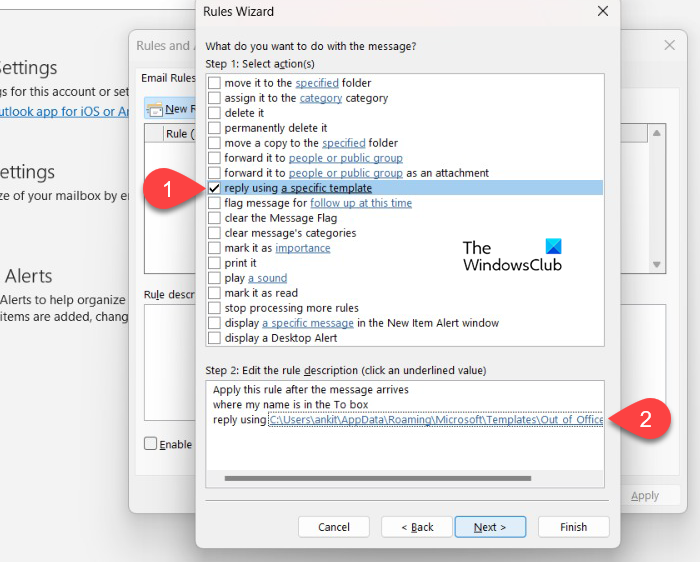
On the fourth screen, you may specify any exceptions to the rule. For example, you may specify any specific recipients or emails to which you do not want to reply. Click on the Next button to move further.
On the fifth screen of the wizard, give a name to the rule and check the box next to the Turn on this rule option. Enable the rule by clicking on the Finish button.
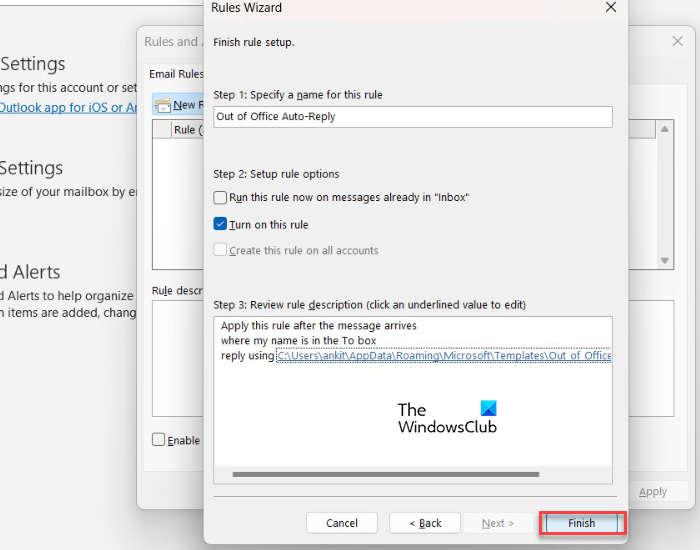
To disable the rule, click on File > Rules and Alerts. Select the rule in the Rules and Alerts dialogues box and click on the Delete button on top.
That’s it! I hope you find this useful.
Also Read: How to reset Outlook view to default on Windows PC.
How do I enable and disable Reply All in Outlook?
Reply All is enabled by default in Microsoft Outlook. If you want, you may disable the Reply All feature in Outlook by creating a form. Switch to the Developer tab and select Design a Form. In the Design Form window, select Message and click on Open. Then select Actions > Reply to All > Properties. Uncheck the Enabled box and click on OK. Next, click the Properties tab, then check ‘Send form definition with item.’ Then select Publish > Publish Form As. Select an option in the Look In dropdown and name the form. Click on Publish to save changes to the form.
Why is my Out of Office not working?
If the Out of Office feature is not functioning properly in Outlook for Microsoft 365, your Out of Office Rule templates may have got corrupted or you may have exceeded the Out of Office quota and can’t create a new rule. The issue can also be caused when the default (or a specific) domain’s Remote Domain configuration is not set to permit Out of Office messages. In Exchange, the issue may appear due to a backlog of mailbox assistant events.
Read Next: Outlook MailTo link not working in Windows.